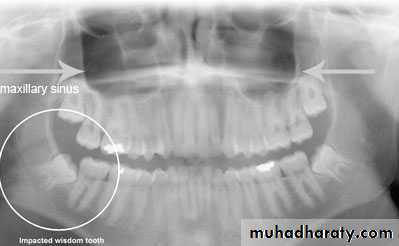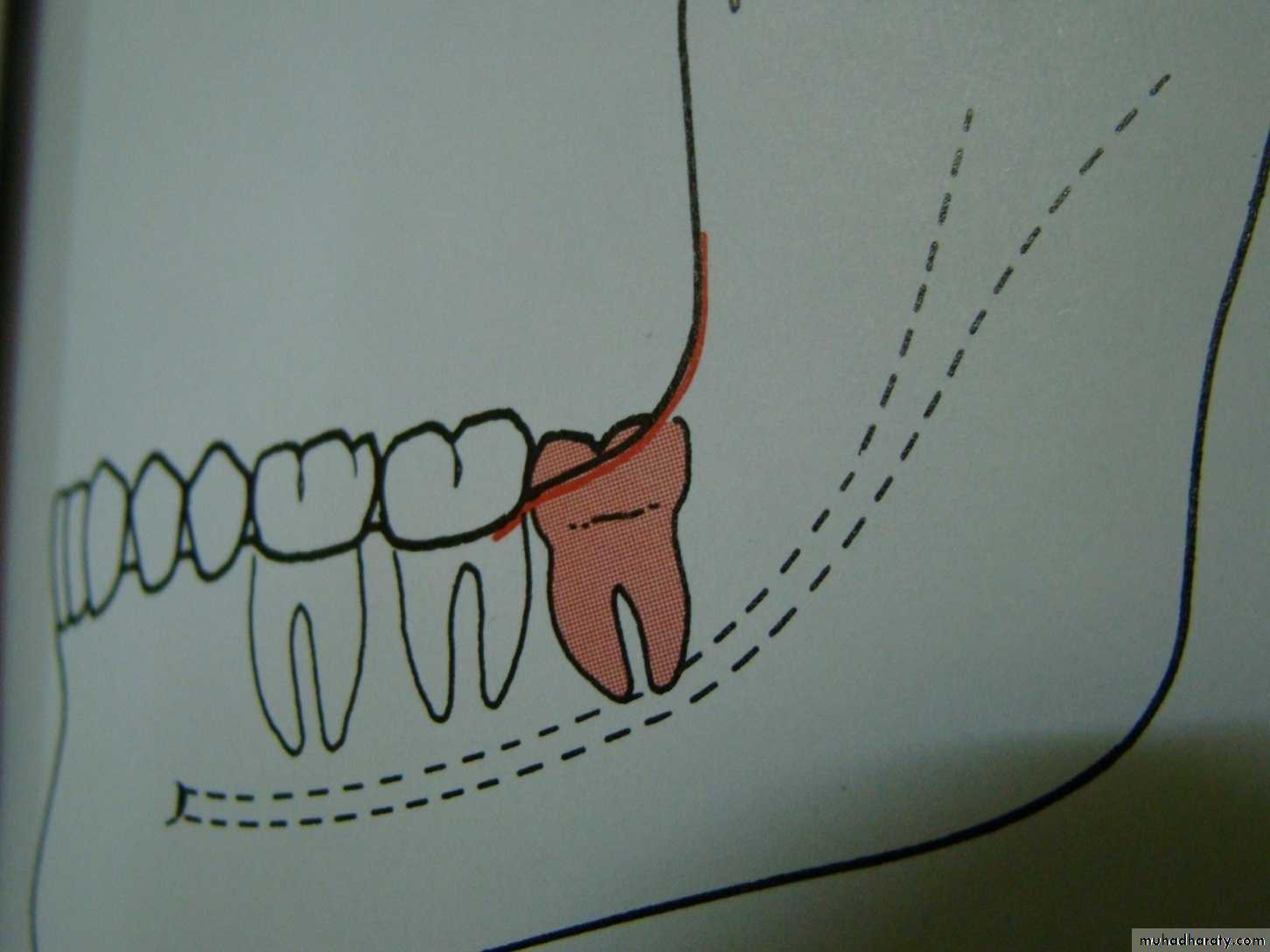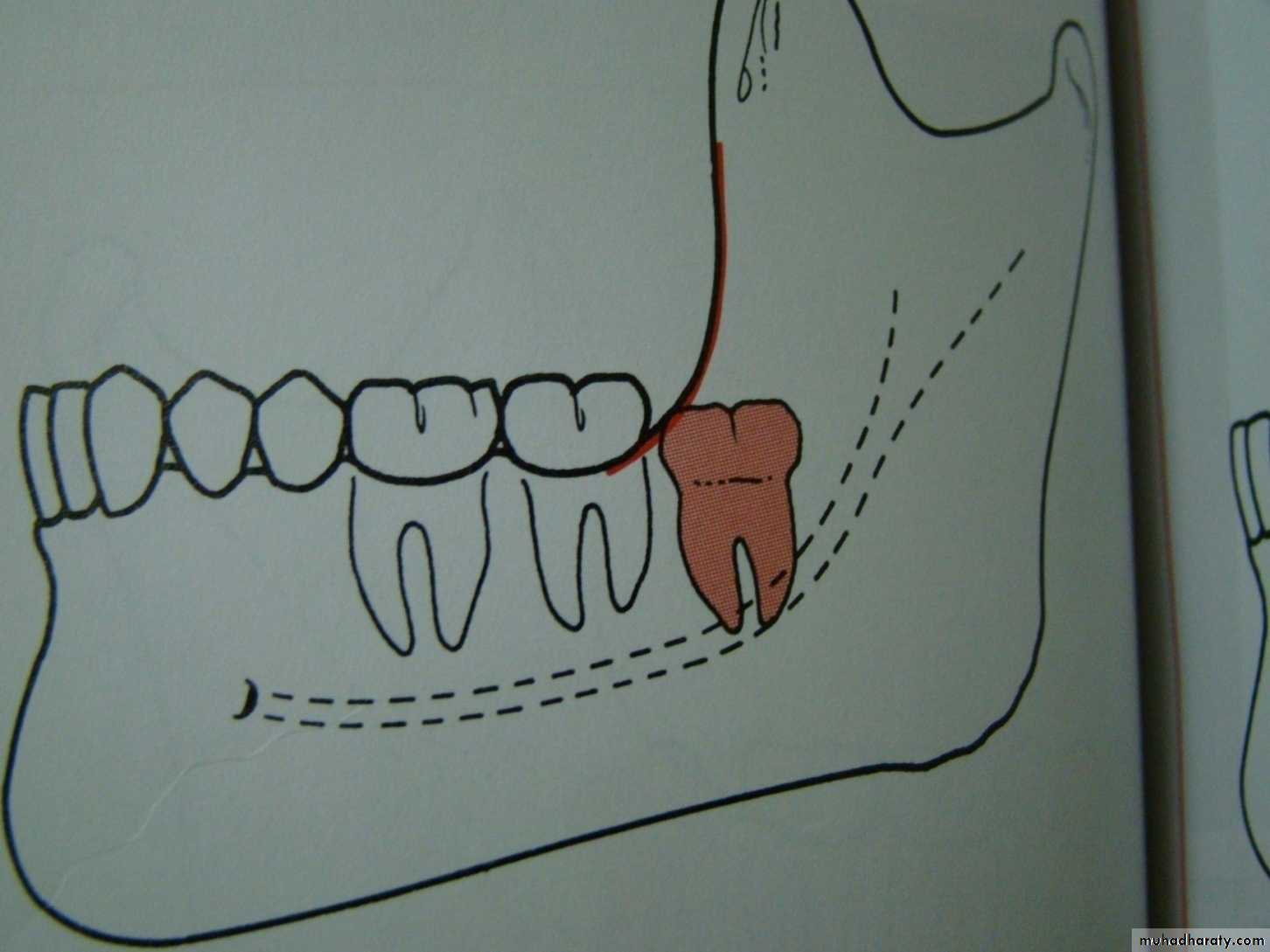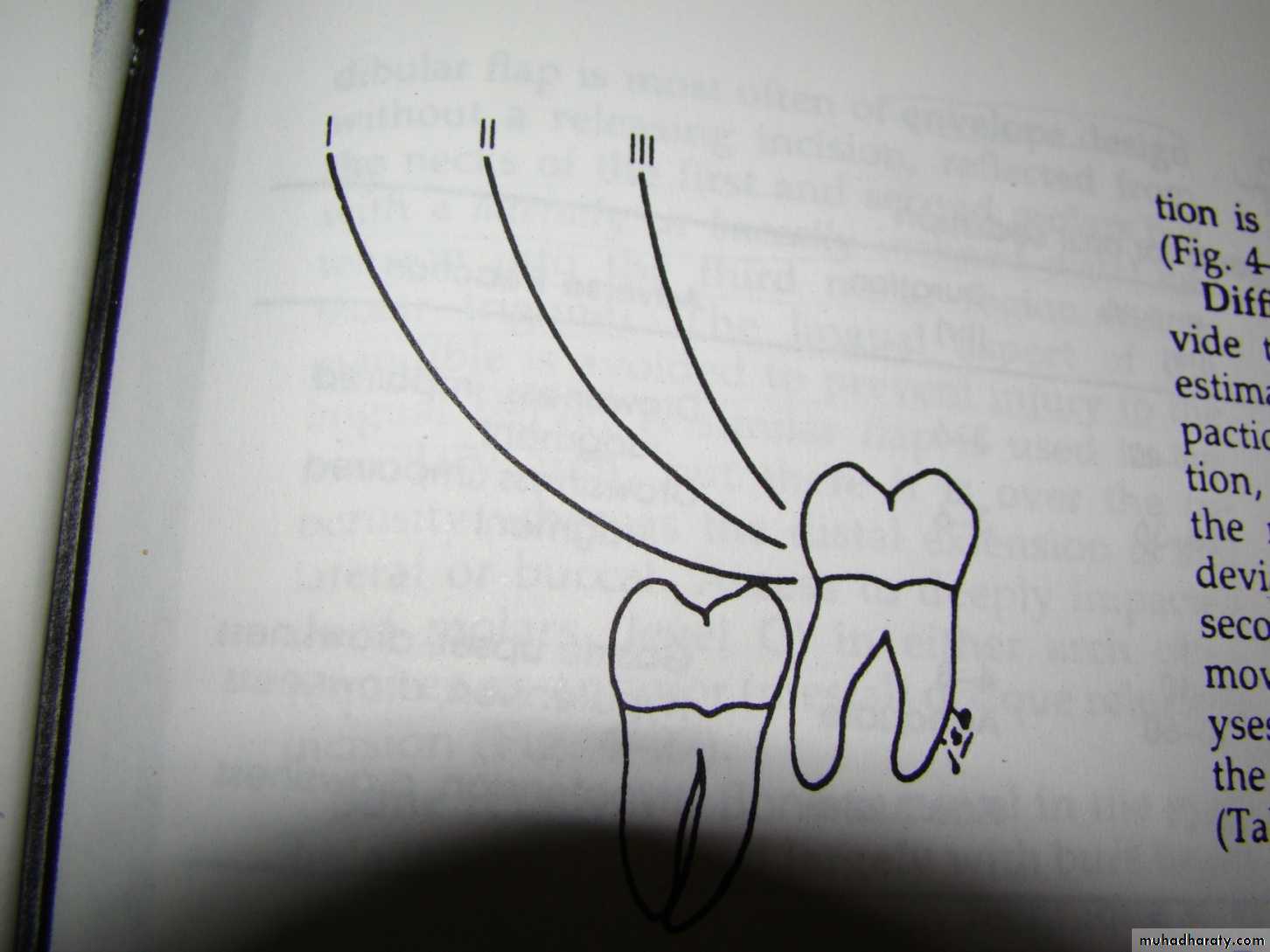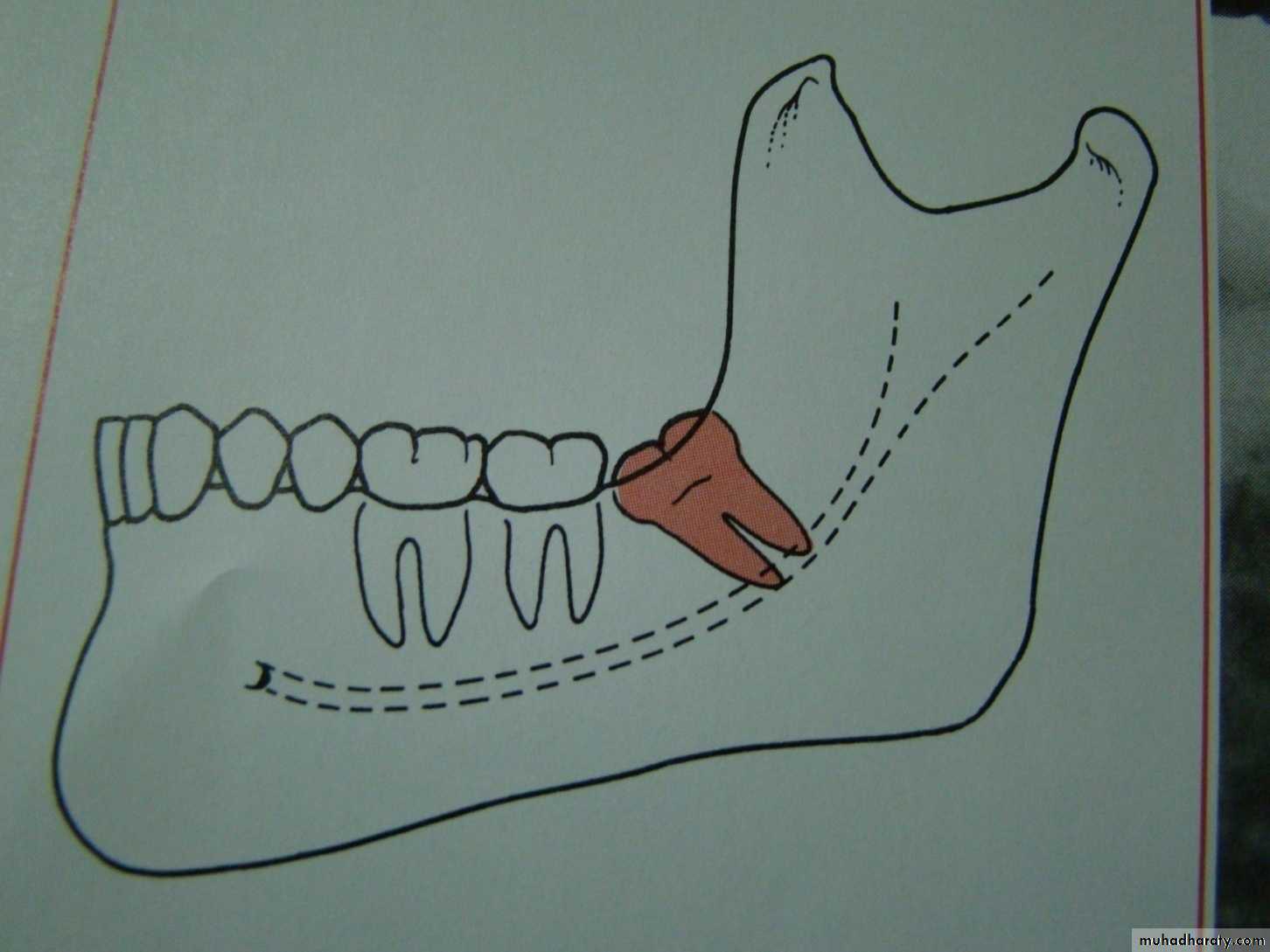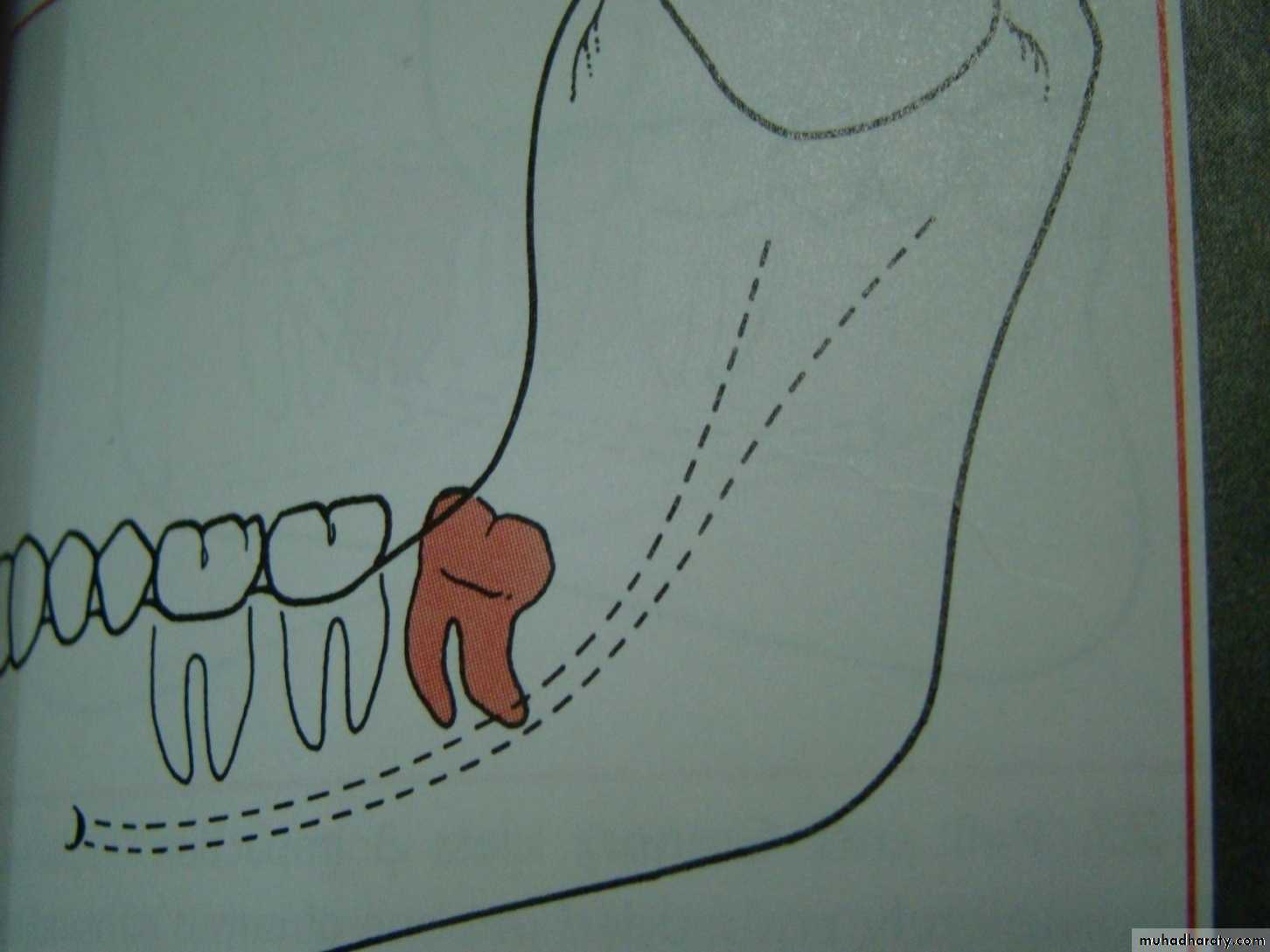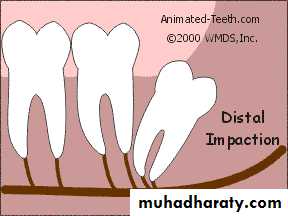Dr . Bara sultan
A lecturer in oral and maxillofacialsurgery
Mosul university
Tooth impaction
Impacted tooth is a tooth that fails to erupt into its normal functioning position in the dental arch within the expected time of eruption . While the term unerupted teeth include both impacted teeth and teeth that are in the process of erupting.
Definition of impacted teeth
3Causes of tooth impaction 1- systemic causes2- local causes
Systemic causes of impaction1- a hereditary syndrome of Cliedo cranial dysostosis2- endocrinal deficiency like hypothyroidism and hypopituitarism3-febrile diseases , downs syndrom,irradiation ( all cause multiple teeth impaction)Local causes of tooth impaction
1 – prolonged retention of deciduous teeth2 – arch length deficiency with large sized teeth
3 – odontogenic cyst or tumor change the path of eruption
4- cleft lip and cleft palate
Frequency of tooth impaction
The frequency of tooth impaction is as follow:1- lower third molar
2 – upper third molar
3- upper canine
4- lower canine
5- lower premolar
6- maxillary premolar
7-maxillary central and lateral incisor
The most common teeth to become impacted are the third molars or "wisdom teeth." Because they erupt so late in life and because most people's jaws are not large enough to accommodate them. Followed by the canines which is the last tooth to erupt in regard to the anterior teeth
Diagnosis of impacted teeth
1- clinical inspection to disclose the missing tooth2- radiographic assessment showing the position of the unerupted tooth
3- standard radiographic technique used to localize the unerupted tooth and these will include
a –the tube shift technique
b – periapical and occlusal filmc – panoramic view (OPG)
D – CT scan if necessary
The tube shift technique
• Uses 2 periapical radiograph , shifting the tube horizontally between exposure• If the impacted tooth moves in the same direction in which the tube is shifted , it is located in the lingual or palatal side
• A facial or buccally located tooth moves in the opposite direction of the tube shift
Treatment options of impacted teeth
1- leave it insitu2 – orthodontic treatment
3 – surgical exposure
4- surgical relocation ( intentional replantation or auto transplantation )
5 –surgical extraction
Indications for impacted tooth extraction
The presence of impacted tooth in the jaw can
cause a variety of problems or complications ,so it should be removed as soon as diagnosis is made , these complications may include
1-Pericoronitis
Pericoronitis is an inflammation of the soft tissues around the crown of partially erupted tooth and is caused by1- the normal oral flora associated with transient decrease in host defense mechanism
2- it may arise secondary minor trauma from upper third molar .
The soft tissue that cover the occlusal surface of the partially erupted lower third molar known as the operculum which can be traumatized and become swollen ,this can be treated by removal of maxillary third molar.
3- food debris accumulation under the operculum
Classification of pericoronitis
1 – acute pericoronitis2- sub acute pericoronitis
3- chronic pericoronitisAcute pericoronitis
It is characterized by a severe throbbing pain which is exacerbated by chewing , interferes with sleep, with limited mouth opening (trismus) . The patient may complain of extra oral swelling and discomfort during swallowing , submandibular adenopathy can be palpated ,and foeter oris may be noted.
In this state tooth extraction is absolutely contraindicated.
Sub acute pericoronitis
It is characterized by a continuous dull ache , some times pus tracks from the third molar region and present in the buccal sulcus alongside the first molar , a condition known as migratory abscess of the buccal sulcus .Chronic pericoronitis
This is characterized by dull pain or mild discomfort lasting for only a day and interspersed with remissions lasting many months . The patient usually complain of unpleasant taste . A crater like defect may be seen in the radiograph of the area .2 – prevention of Dental caries
Dental caries can occur at the lower 8 oradjacent lower 7 most commonly at the
cervical line due to the inability of the patient
to clean the area thoroughly .
23
3 - Prevention of Periodontal disease
Food debris accumulation distal to the second molar and difficulty to clean it may lead to periodontal problems4-Prevention of resorption of adjacent tooth root
If external resorption is small in amount the tooth may repair it self by deposition of a layer of cementum over the resorbed area and the formation of secondary dentin . But if the resorption is severe both second and third molar may require removal .
5- Pain of unexplained origin
Occasionally patient complain of jaw pain at the area of impacted third molar that has neither clinical nor radiographic signs of pathology . removal of this impacted tooth may relieve this pain .6 - Prevention of odontogenic cysts and tumors
The dental follicle may undergo cystic degeneration like a Dentigerous cyst ( which arise from the reduced enamel epithelium) or odontogenic keratocyst ( which arise from the dental lamina ) . Ameloblastoma may develop from epithelium within the dental follicle .Dentigerous cyst causes tooth impaction
7 - Tooth in the fracture line
Impacted lower third molar may weakens the angle of the mandible and make it more liable to fracture during trauma to the face . The tooth should be removed if the fracture treated by open reduction .and it is preferable to leave the tooth insitu if the fracture treated by closed reductionAsymptomatic deeply impacted tooth can be safely left in place but if the bone overlying the tooth is very thin or absent the tooth should be removed before construction of the prosthesis .
8 - Impacted tooth under dental prosthesis
9 - To facilitate orthodontic treatment
1- crowding of mandibular incisors :in fact anterior incisor crowding is associated with arch length deficiency rather than the mere presence of impacted tooth
2 – if the orthodontist is attempting to remove the molars distally , removal of the impacted third molar may facilitate treatment.
3-interferance with orthognatic surgery especially in mandibular osteotomy or mandibular advancement surgery.
Contra indications for removal of impacted tooth
1 – extreme of age2- compromised medical status
3- probable unnecessary excessive damage to adjacent structures .
4- acute pericoronitis.
Classification of impacted teeth
This is done to help the dentist in evaluation the extent and difficulty of the surgical procedureClassification of impacted lower third molar
1- Pell and Gregory classification according to the depth or according to the relation of the impacted tooth to the occlusal plane of the lower second molar2- Pell and Gregory classification according to the relation ship of the lower second molar to the anterior border of the ramus
3- Winters classification according to the angulations of the long axis of the impacted tooth
according to the depth
Level A the highest point of the occlusal surface of the impacted tooth lie with or above the occlusal surface of the second molarLevel B the highest point of the impacted tooth lie below the occlusal surface but above the cervical surface of the lower second molar
Level C the highest point of the occlusal surface o f the impacted tooth lie below the cervical line of the lower second molar .
Relation of the impacted tooth to the anterior border of the ramus
Class 1 : the space between the lower second molar and the anterior border of the ramus is sufficient to accommodate the mesio distal dimension of the crown of the impacted lower third molarClass 2 : the space between the lower second molar and the ramus is insufficient to accommodate the crown of the impacted tooth .so part of it in the body and the other part lie in the ramus .
Class 3 the anterior border of the ramus lie near the distal surface of the lower second molar ,so ,the whole impacted tooth lie within the ramus .
Impacted tooth in relation to the ramus
Winters classification of impacted lower third molar
Mesio angularDisto angular
Horizontal
Vertical
Inverted
Transverse
Buccoversion
Linguversion
52
Classification of impacted upper third molar
1- pell and Gregory according to the relation of the impacted tooth to the occlusal plane of the upper second molar2- the relation of the impacted upper third molar to the maxillary sinus
According to the depth
Level A the lowest point of the occlusal surface o the impacted upper third molar lie with or below the occlusal plane of the upper second molar.Level B the lowest point of the impacted tooth lie between the occlusal and cervical line of the second molar
Level C the impacted tooth above the cervical line of the maxillary second molar
Relation of the impacted maxillary third molar to the maxillary sinus
Class A sinus approximation ( less than 2 mm bone between the antrum and the impacted tooth )Class B non sinus approximation ( more than 2 mm of bone exist between the impacted tooth and the sinus )
Classification of impacted maxillary canine
Class 1 palataly impactedClass 2 labially impacted
Class 3 intermediate
Class 4 impacted canine in edentulous patient


